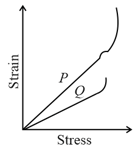HARD
Earn 100
Explain stress versus strain graph with the help of a neat labelled diagram.
Important Questions on Elasticity
EASY
HARD
Calculate the strain energy per unit volume in a brass wire of length and area of cross-section when it is stretched by and a force of is applied to its free end.
MEDIUM
HARD
EASY
MEDIUM
EASY
MEDIUM
HARD
EASY
MEDIUM
= Young's modulus of the material of rod, coefficient of linear expansion
MEDIUM
MEDIUM
MEDIUM
MEDIUM
MEDIUM
EASY
EASY
HARD


